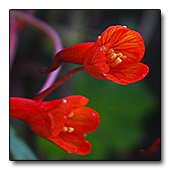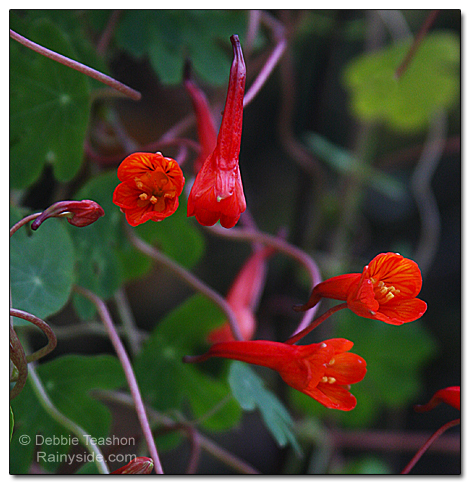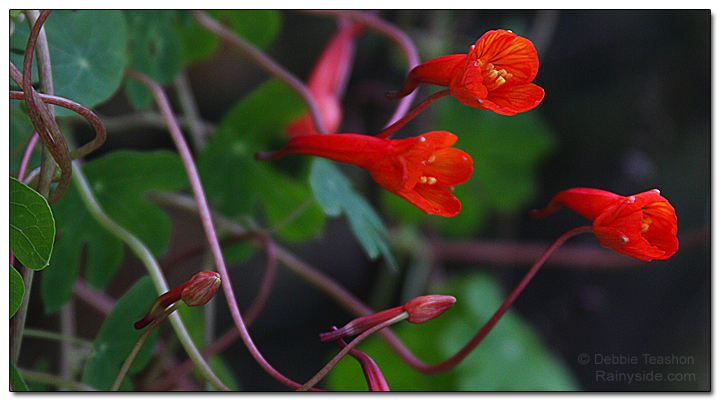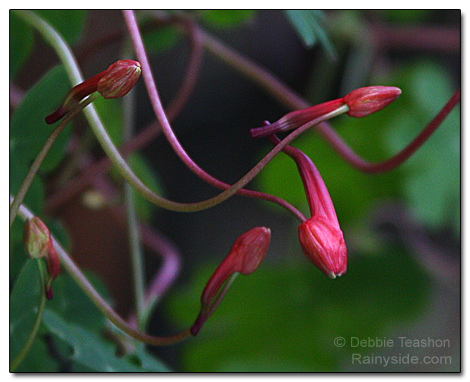MASHUA, TUBEROUS NASTURTIUM, AÑU, ISAÑO, CUBIO
syn. N/A
Family: Tropaeolaceae
Pronounced: tro-PEE-o-lum too-bur-OH-sum

Quick Jumps
Growing Guide
Rainy Side Notes
GROWING GUIDE

Origin:
Andes Mountains of Bolivia, Peru, Ecuador, Columbia, and Venezuela.
Plant group:
Vines.
Hardiness:
Sunset zones: Not listed.
USDA zones: 8-15.
Heat zones: 12-8.
Mature size:
Height: 8-13 feet (3-4 m).
Flowering period:
Midsummer to autumn.
Flowering attributes:
Long-spurred, orange, red, or orange and yellow, ¾ to 1 ½-inch long, trumpet-shaped flowers.
Leaf attributes:
Three to six-lobed, gray-green leaves form on long twining stems.
Light:
Full sun. Where temperatures frequently climb above 80° F, give the vine afternoon shade.
Soil:
Grows on a wide range of soils, but thrives in moist, moderately acidic, organic soil. Nitrogen rich soil delays flowers.
Feeding:
Mulch with compost. Fertilize once in early spring with a complete organic fertilizer. After first fertilizing, do not use a nitrogen fertilizer.
Propagation methods:
Plant seeds 3 months before last frost, about 1-inch deep at 55-60° F and no warmer. Germination is irregular and slow.
Divide tubers.
Pests and Diseases:
Cabbage butterfly larvae, flea beetles, and aphids. Deer, mice, and voles are sometimes problematic.
Rainy Side Notes


Equally important as a root crop of potatoes, Tropaeolum tuberosum was grown and developed as a crop, high in the Andes Mountains. Here in the Northwest, we mainly grow it for its ornamental value.
Tropaeolum tuberosum has many common names – known in Peru and Bolivia as Añu, in Peru as Mascho, in Ecuador as Mashwa, and in Columbia as Cubio. Other common names include Mashua, Tuberous Nasturtium, Isaño, Mazuko, and Maswallo.
The South American plant is not easy to grow outside of its native region, Mashua (pronounced Mah-shwuh) thrives in mild maritime climates such as the Northwest and Britain. In England, the vine received the prestigious Royal Horticultural Society's Award of Garden Merit. The best places in the Northwest to grow are the Puget Sound basin, along with the Northwest coast, San Juan and the Gulf Islands, and southern Vancouver Island. During the hot summer months, the vine will struggle in the heat in Oregon's Willamette Valley and need more water.
The vine produces tubers that look like a potato, with dimpled eyes. Capable of growing up to 13 inches long, most will grow three to eight inches. Each plant will yield approximately 5 pounds per plant. Colors range from white, yellow, red, and purple, with some tubers striped or mottled. Raw, the taste is sharp and peppery, much like radishes, which is attributed to isothiocyanates (mustard oils). Cooking tamps the sharp taste down to a more turnip-like flavor. People around the world utilize the tubers for food.
The leaf flavor is reminiscent of the peppery taste of common nasturtiums (Tropaeolum majus) or mustard greens (Brassica juncea), only milder. Raw leaves add a delicious, spicy flavor to salads, and also used as young leaves for boiled greens. Like a grape leaf, use the larger leaves as a wrap.
The tubers are an excellent source of nutrients, rich in vitamins, minerals, and are high in protein and fiber. The large flower nectary harbors sweet, anise-like nectar.
The vine widely used in Andean folk medicine for its antibiotic, insecticidal, nematocidal, and diuretic properties, yet there are many traditional ways to use the plant. To repel pests in Columbia, farmers plant the vine as a border to surround their potato fields and other crops.
Originated in the Titicaca basin of Peru and Bolivia, there is evidence that tubers found in archaeological digs and pre-Incan pictograms show that Mashua and other crops were an important food source in those times. Domestication of the vine is estimated around 5500 B. C. The plant introduced to Europe in 1827, became popular as an ornamental vine.
At planting time, cut the tubers with at least two eyes for each piece, or planted whole. After the last frost in spring, dig a hole, and plant the tubers at least two to three inches deep. You can pot them up as a bunch and grow them in a frost-free place. When the danger of frost has passed, divide and transplant the small plants into the garden or a container.
Use a trellis for them to climb on, or let them sprawl on the ground where they will form a weed-suppressing mound. Grow the vines in a large container such as a ½ wine barrel size or larger, for ornamental or edible use. Select the largest tubers to save for next year's crop. Large tubers produce large plants.
Two varieties that flower in August until the first frost include 'Ken Aslet' and 'Hahamish'. 'Ken Aslet' has a red-orange spur with yellow petals, and 'Hahamish' has orange spur and petals. Nitrogen-rich soil will delay flowers.
Mashua is a prime source of nectar for hummingbirds and bees.
Debbie Teashon

Gardening for the Homebrewer: Grow and Process Plants for Making Beer, Wine, Gruit, Cider, Perry, and More
By co-authors Debbie Teashon (Rainy Side Gardeners) and Wendy Tweton
Copyright Notice | Home | Search | Vines

